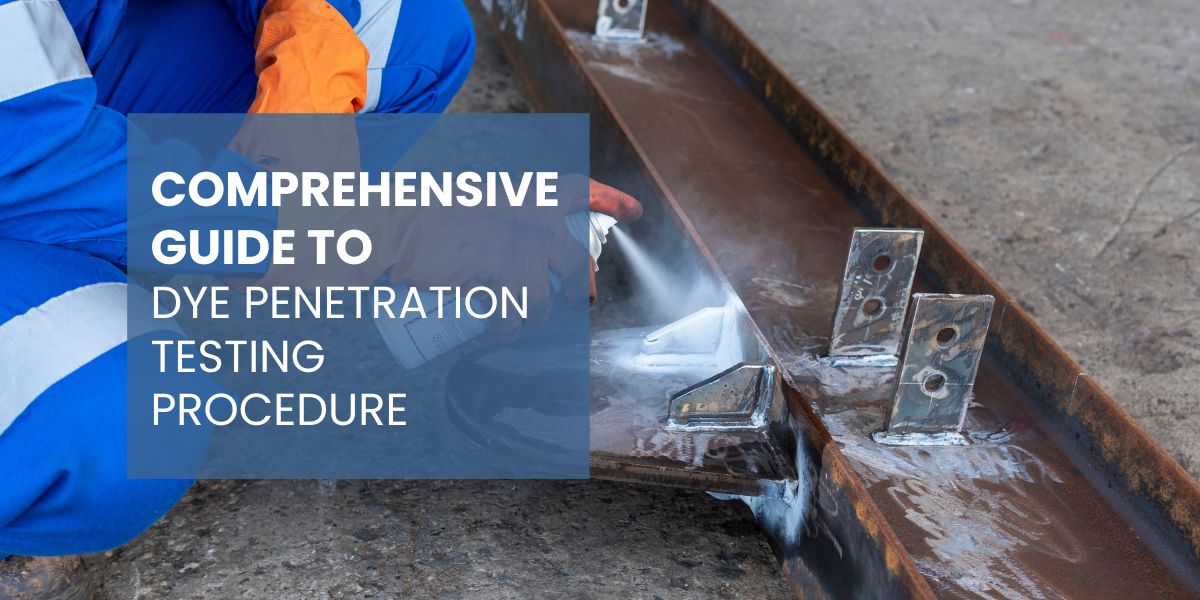
Dye penetration testing (DPT) is a non-destructive testing (NDT) technique that is used to find surface-breaking defects in a variety of materials. This is a popular testing method for detecting faults such as cracks, porosity, laps, seams and other surface discontinuities across various industries in the UK. In this blog, we are going to take a look at dye penetration testing procedure, its applications, advantages and limitations, to help you determine if you should choose this procedure for flaw detection.
What is Dye Penetrant Testing?
Dye penetrant testing involves applying a low-viscosity liquid penetrant to the surface of a material. This penetrant can seep into any surface-breaking flaws due to capillary action. After allowing sufficient time for the penetrant to dwell, the excess is removed and a developer is applied. The developer makes the penetrant visible for inspection by drawing it out of the defects. This method is particularly effective for non-porous materials and can detect various defects such as cracks and porosity in castings, forgings and welded components.
The Dye Penetration Testing Procedure
The dye penetration testing procedure consists of several steps which are listed below:
Step 1: Surface Preparation
The first step in the dye penetration testing procedure is to clean the surface thoroughly. During this step contaminants such as dirt, grease, oil and paint are removed from the surface to ensure that any defects present are accessible for the penetrant to enter effectively. If contaminants are present, it may lead to inaccurate results and missed defects.
Step 2: Application of Penetrant
Once the surface is prepared, the liquid penetrant is applied. This can be done through dipping, spraying or brushing. After application, the penetrant is allowed to stay on the surface for a specific period of time (five minutes to one hour depending on factors like viscosity and defect size). When working with high-viscosity penetrants or smaller defects, a longer dwell time is generally required.
Step 3: Removal of Excess Penetrant
After sufficient dwelling time, any excess penetrant is removed from the surface. This step is vital because otherwise any leftover penetrant can mask indications of defects during inspection. The common removal methods include water-washable or solvent-removable techniques, however, it may vary based on the type of penetrant used.
Step 4: Application of Developer
A developer is applied to the surface after the extra penetrant has been removed. The developer can be in powder form or liquid and it helps to draw out any trapped penetrant from defects. This process enhances visibility of the flaws by creating a contrasting background against which defects can be seen clearly. The developer is allowed to remain on the surface for an adequate time, so the penetrant can effectively bleed-out.
Step 5: Inspection
To perform the inspection appropriate lighting conditions are required, which will depend on the type of dye used; ultraviolet light is generally used for fluorescent dyes and white light is needed for visible dyes. After allowing sufficient development time (typically 10-30 minutes), the surface is then examined for indications of defects. To accurately identify defects and interpret indications, you need inspectors with proper training, like our experts at Gammax.
Step 6: Post-Cleaning Considerations
Once the inspection is complete, it is essential to clean the surface again to remove any residual penetrant or developer that maybe present. This step prevents contamination and ensures that the component can be safely used without any interference from testing materials.
Remember to appoint certified experts for the dye penetration testing procedure to ensure you receive accurate reports.
Applications of Dye Penetration Testing
Dye penetration testing procedure is used across various industries to detect flaws in various materials, for example:
1. In aerospace industry it is used to detect defects in components like turbine blades, which could compromise safety.
2. In automotive manufacturing, DPT is used frequently to check welds and engine components for structural integrity.
3. In petrochemical sector, it helps to inspect pipelines and pressure vessels to prevent leaks in hazardous environments.
4. It is also used in manufacturing as a quality control measure in metalwork and fabrication processes.
5. Construction industry also uses the dye penetration testing procedure to assess weld integrity in steel structures in order to comply with safety standards.
6. It is also used in railway infrastructure to detect flaws in rails and welds, which helps to maintain operational reliability.
Advantages of Dye Penetration Testing
Dye penetration testing offers several benefits over other non-destructive testing methods, such as:
Cost-Effective: Compared to other NDT methods, DPT is relatively less expensive.
Versatility: Unlike other NDT methods, dye penetration testing procedure is suitable for various materials including metals, plastics and ceramics.
High Sensitivity: DPT is capable of detecting very small surface defects effectively.
Visual Indications: DPT provides clear visual evidence of defects which aids in documentation and assessment.
Limitations of Dye Penetration Testing
Despite its advantages, dye penetration testing procedure has some limitations, for example:
- It only detects surface-breaking defects, which means any subsurface flaws may remain undetected
- DPT requires careful surface preparation for accurate results
- Environmental factors such as temperature and humidity can affect the accuracy of DPT
Conclusion
Dye penetration testing procedure is used across numerous industries for maintaining safety and quality standards by effectively detecting surface defects in critical components. Its comprehensive procedure ensures that potential flaws are identified early and addressed on time, which could have serious consequences otherwise.
Gammax Independent Inspection Services LTD: Your Trusted Experts for DPT
If you are looking for certified experts who can conduct DPT safely and accurately, we are your best option here at Gammax Independent Inspection Services Ltd. Our experts are BS EN ISO 9712 certified and our company works under UKAS accreditation in accordance with ISO 17020. These certifications ensure that we follow industry standards and best practices in everything we do. For more information regarding our DPT service, get in touch with our team today!
